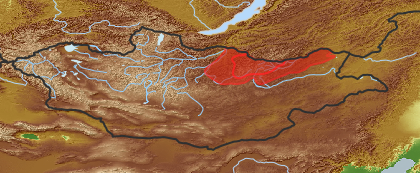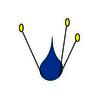| Class: | gymnosperms |
| Order: | Pinales |
| Family: | Pinaceae |
| Genus: | Larix |
| Scientific name: | Larix gmelinii (Rupr.) Kuzen. |
| Name acc. to: | Flora of China, Vol. 4 |
| Synonym: | Larix dahurica Turcz. ex Trautv. (acc. to Flora of Siberia, Vol. 1 (1988/2000)) |
| Description: | Cones globose, small about 1.5x2 cm, when mature usually heavily divaricate; scales broad-spatulate, almost flat, with upper margin truncated straight or slightly emarginate, glabrous, less than 20 in number. |
| Tax. Comments: | Gubanov 1996 used the older name L. dahurica Laws. Agric. Man. 389. But the name Larix dahurica is published 1836 by Charles Lawson without description, and is therefore invalid. |
| Link to Flora of China: | http://www.efloras.org/browse.aspx?flora_id=2&name_str=Larix+gmelinii |
| open map in a new window |  |
| Habitat: | Hills, mountains, rocky slopes, peatlands, swamps, lowland subarctic plains, river basins, valleys; 300-2800 m (acc. to Flora of China) |
| Habit (i)general appearance of a plant | |
| Growth form: (i)Herb, shrub, tree or climber. | tree (i)Woody plant with a clear main trunk, at least 2-3 m tall
example: Ulmus pumila   inherited by family Pinaceae: tree inherited by family Pinaceae: tree
|
| Parasite status: (i)Is the plant a half- or full parasite? | no parasite/saprophyte (i)Plant fully autonomous, leaves with chlorophyll
example: Most plants, Ranunculus  inherited by vasc. plants: no parasite/saprophyte inherited by vasc. plants: no parasite/saprophyte
|
| Water or terrestrial plant: (i)Where do the plants grow? | terrestrial (i)Plant grows on dry land
example: Orostachys spinosa  inherited by vasc. plants: terrestrial inherited by vasc. plants: terrestrial
|
| Leaf (i)expanded, usually photosynthetic organ of a plant (including phylloclades) | |
| Leaf development: (i)Structure and development of leaves. | with green leaves (i)Plant with green leaves  inherited by vasc. plants: with green leaves inherited by vasc. plants: with green leaves  inherited by family Pinaceae: with green leaves inherited by family Pinaceae: with green leaves
needles or scales (i)Leaves short, broad more or less adjacent to axis (scales)) or acicular (needles)
example: Pinus (needles), Cupressus, Ephedra (scales)   inherited by vasc. plants: needles or scales inherited by vasc. plants: needles or scales
|
| Leaf arrangement: (i)Arrangement of leaves at the stem. | others ? (i)Not as above (soll gelöscht werden)  inherited by family Pinaceae: others ? inherited by family Pinaceae: others ?
|
| Simple or divided leaves: (i)Are the leaves simple or completely divided in several parts? Blade of the leaf entire or (more or less) deeply dissected. Attention: There are various appearances of the leaf margin (from entire to toothed and lobed). Here, we ignore this and ask only for dissections that separate the leaf for more than one third of its length or width, whatever is smaller. Sometimes, it is difficult to tell apart compound leaves from a shoot system with simple leaves: look for stipulae and/or axillary buds at the ground of the leaves: if only some possess these structures, the others are most likely leaflets of a compound leaf. | simple (i)Non-divided leaf, but margin may be incised nearly to the ground   inherited by family Pinaceae: simple inherited by family Pinaceae: simple
|
| Shape of blade: (i)Easy for simple leaves. In compound leaves use the general shape of leaflet. Always check the ground for largest leaves of a plant. To be worked out: how to handle pinnate leaves? | linear incl.grasslike or oblong (i)Leaves more than two times longer than broad with more or less parallel margins; see character: stipule for ligula
example: Dracocephalum ruyschiana, Poaceae, Scutellaria scordifolia, Pinus   inherited by family Pinaceae: linear incl.grasslike or oblong inherited by family Pinaceae: linear incl.grasslike or oblong
|
| Leaf margin: (i)Structure of leaf margin (or that of a leaflet in case of compound leaves). Attention: Here we ask for the leaf margin, defined as all those dissections that separate the leaf for less than one third of its length or width, whatever is smaller. To be worked out: how to handle margin of pinnate leaves? | entire (i)Plain margin, not toothed
example: Iris   inherited by family Pinaceae: entire inherited by family Pinaceae: entire
|
| Flower (i)reproductive portion of the plant, consisting of sepals, petals, stamens, and pistils | |
| Perianth arrangement: (i)Attention: in some plants, flowers may be dimorphic in different ways (dioecious or gynodioecious). If flowers vary, record the characters of the most showy flowers. | absent or strongly reduced (i)No perianth leaves ensheathing stamen and/or carpels
example: Callitriche   inherited by vasc. plants: absent or strongly reduced inherited by vasc. plants: absent or strongly reduced
|
| Ovary position: (i)For entirely or partly fused carpels, describe their position in relation to the insertion point of perianth leaves (best done by doing a longitudinal section of a flower). | absent (i)Without ovary: male flowers  inherited by order Pinales: absent inherited by order Pinales: absent
|
| Sex: (i)Distribution of male and female organs among flowers, only most commonly cases. | unisexual (i)
example: Rhodiola  inherited by vasc. plants: unisexual inherited by vasc. plants: unisexual  inherited by family Pinaceae: unisexual inherited by family Pinaceae: unisexual  inherited by genus Larix: unisexual inherited by genus Larix: unisexual
monoecious (i)Male and female flowers at the same plant
example: Xanthium, Larix, Atriplex  inherited by family Pinaceae: monoecious inherited by family Pinaceae: monoecious  inherited by genus Larix: monoecious inherited by genus Larix: monoecious
|
| Inflorescence (i)flowering part of a plant, describes the arrangement of the flowers on the flowering axis | |
| Inflorescence type: (i)Types of inflorescence. Attention: We here ask for the botanical nomenclature of inflorescences, which is sufficiently complicated. Tick only, if you are certain, or tick all inflorescence types that appear similar of these of the plant in question. | Cone (i)Flowers densely arranged along a short, often thickened axis, looking towards all sides
example: Pinus, Ephedra   inherited by vasc. plants: Cone inherited by vasc. plants: Cone
|
| Fruit (i)the seed bearing organ, with or without adnate parts; a ripened ovary and any other structures which are attached and ripen with it. Aggregate fruits are handled like simple fruits for determination. | |
| Type of fruit: (i)Common fruit types (including pseudocarp). | cone (i)No fruit, but often considered as fruit
example: Pinaceae, Cupressaceae, Ephedraceae   inherited by vasc. plants: cone inherited by vasc. plants: cone
Pseudofruit (i)Special types of diaspores, often no real fruits  inherited by vasc. plants: Pseudofruit inherited by vasc. plants: Pseudofruit
|
| Distribution (i)region where the plant is likely to be found | |
| Distribution (Veg. Zones): (i)acc. to Grubov 1952 | Khentei (i)In distribution data often named as '2' 
Mongol-Daurian (i)In distribution data often named as '4' 
acc. to: Gubanov 1996 |
| Plant Status | |
| Red list status: (i)Rare Mongolian plants | rare (Shiirevdamba 2007) (i)Rare plant
|